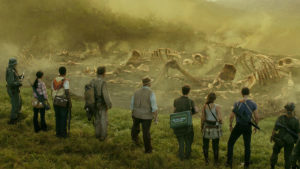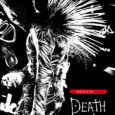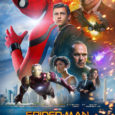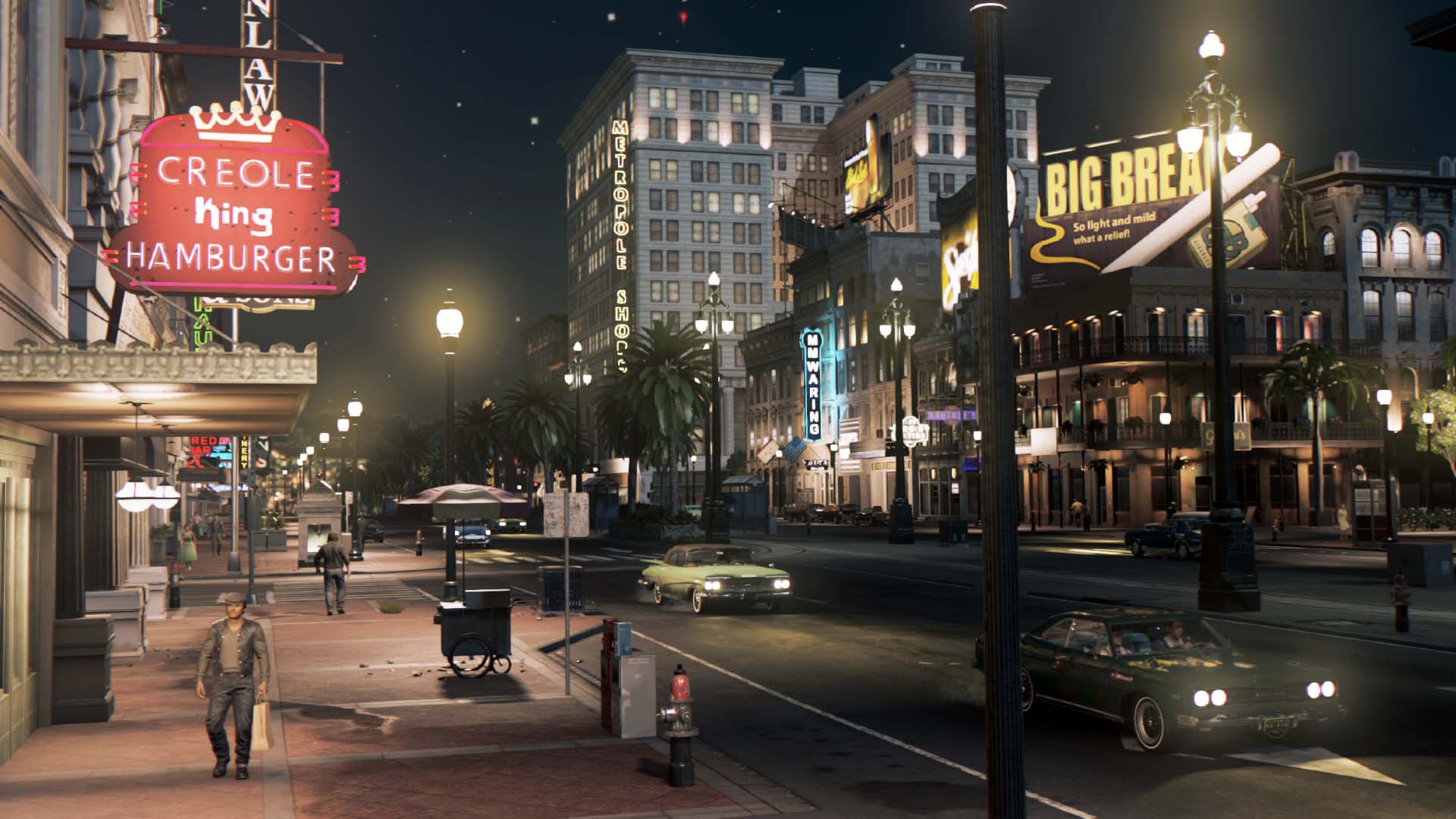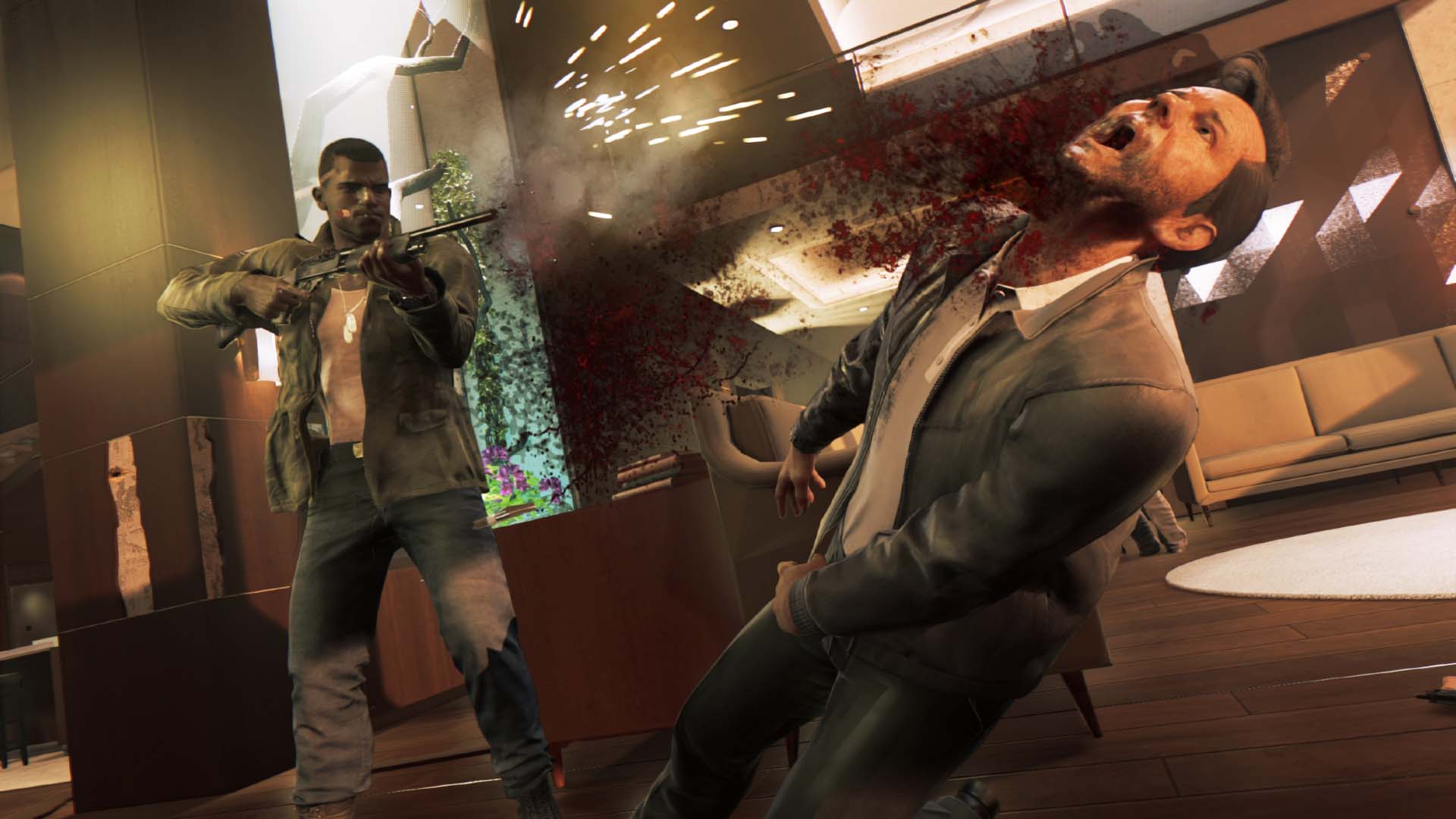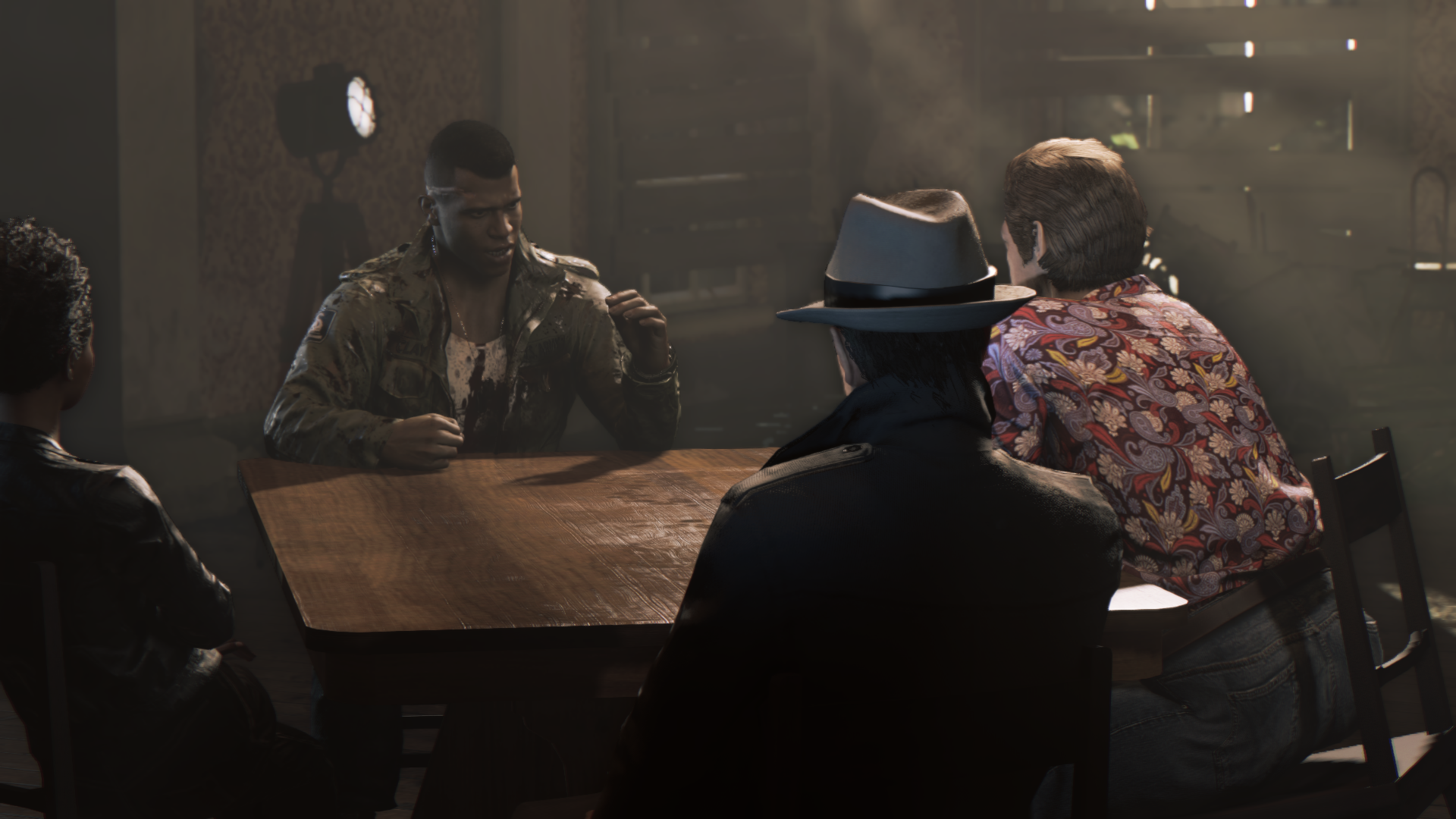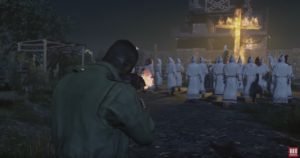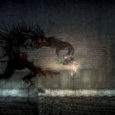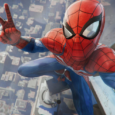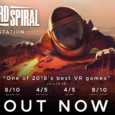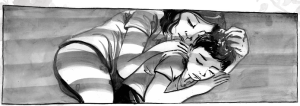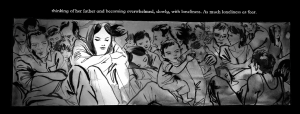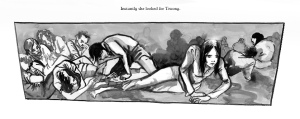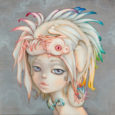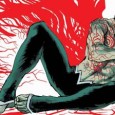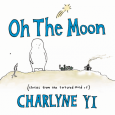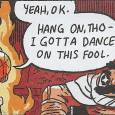If a tree falls in a forest, and a mythological gigantic ape picks it up to use it as a weapon, does it make a sound? Yes, that sound is me in the theater audibly uttering “wow” through a giddy smile. This is the true test Kong: Skull Island has to pass or fail. Could it not only entertain but “wow” audiences with its spectacle? Fortunately, it unquestionably amazes with its stunningly-crafted CG and scale, but it’s at the expense of smooth dialogue and strong characters.
In the latest Kong retelling, the story is as thin as you’d expect, since the emphasis is on the origins of these monsters. As the Vietnam war comes to an end, a group of determined scientists implores the government to send a military escort with them to an undiscovered island. Along the way, said scientists hire a tracker (Tom Hiddleston). Separately, a photographer tags along (Brie Larson). The plot broken down in a sentence is essentially “some dummies go to Kong’s island to study things.” I’m never a fan of being reductive, but a film isn’t supposed to make it so easy to do. Regardless, I suppose that’s not why we eagerly watch these types of popcorn blockbusters.
Commendably, Warner Bros. Pictures employs one of the strongest ensemble casts you’ll see in a movie all year. Hiddleston, recent Oscar winner Larson, Samuel L. Jackson, John Goodman, John C. Reilly, Toby Kebbell, Shea Whigham, Thomas Mann, and Jing Tian star, to name a few. The film also features a Straight Outta Compton reunion with cast members Jason Mitchell (Easy E) and Corey Hawkins (Dr. Dre). The casting aspect alone held so much promise on paper, but this potential felt largely squandered.
Sam Jackson and John C. Reilly are clearly taking liberties and enjoying it in their respective roles, but everyone else is strikingly forgettable. There’s attempted interplay between a couple of the marines that ultimately falls flat. Heavy-hitting actors Hiddleston and Larson are simply present to be a conduit of plot details for us, the audience. Most of what they do while on camera is react with the best surprised expression they can muster. Sure, the two have distinct occupations but it’s merely an excuse to carry them into this dangerous adventure. Not to mention, Hiddleston’s James Conrad did very little tracking at all. As far as definitive personality traits, I didn’t notice any from Hiddleston, Larson, or the many other expendable individuals.
As I touched on, Reilly and Jackson are a blast to watch as they chew up their scenery. Whether improvised or purposefully written, the jokes never seem to land pre-Reilly. Like he does in his prior comedic work, he has a natural delivery and general presence that inspires laughter. Jackson as Colonel Packard recited some insane lines in the vein of a cheesy ’90s action villain with such hilarious conviction. The duo was nothing short of a joy to see perform.
We have to praise the real star of the show: Kong. Everything about him in Skull Island exceeded my expectations. If your primary complaint of 2014’s Godzilla was “where’d that enlarged lizard thing go?,” prepare to be satisfied. Kong appears in the first 3 minutes, and they don’t hold back as a means to build tension (which I personally appreciated in the latest Godzilla effort). At times, he’s spotted merely walking around the island, and every frame he occupies feels majestic. Terry Notary put forth a tremendous motion-capture effort that added a surprising amount of nuanced personality to the familiar beast. More than that, Kong is written with a layer of ingenuity. In his several oversized-creature battles, he uses his surroundings and tools he might spot at random to their full potential to aid him in bringing down his enemies. Kong himself should satisfy the majority of moviegoers.
Another facet I appreciated from the picture was director Jordan Vogt-Roberts‘ work behind the camera. There are plenty of carefully constructed frames with a remarkable colorful concoctions. After the movie rushes past certain crudely-written scenes with one-dimensional supporting characters, Vogt-Roberts squeezes in intricately vibrant set pieces. Whether it’s a fast-paced action sequence involving an abundance of fire or Kong purely looking at a sunrise, he shows off his knack for capturing the beautiful production design in a visually-palpable way. Unfortunately, he’s not given many opportunities to display these skills on more than a couple occasions.
I may have levied quite a few criticisms against this flick. Nevertheless, a visit to the theater to see Kong: Skull Island on the silver screen is a good investment. If you expected occasional astounding visuals and fantastic monster fights, then Skull Island will distribute that in spades. Anticipating tangible character development and dialogue that doesn’t make you cringe is simply too much to ask. While we always prefer a satisfying mixture of both, Kong is still an enjoyable (literal) giant blockbuster. Also, don’t forget to remain seated for a post-credits tease. You’ll start to see how the larger Warner Bros. MonsterVerse starts to connect, and it’s very exciting.
Grade: C
The Mafia series has always been remembered for its amazingly constructed stories. The focus points have always been characters and narrative, and Mafia III continues this trend. Despite an early exposed gameplay loop and some slight graphical issues, I never found myself bored with this seemingly polarizing game.
I grew up with family in New Orleans so the setting of Mafia III, New Bordeaux, really speaks to me. The roaring late 60’s jams gives me vibes of old car trips with my parents and the music of their generation.This game brought up a bunch of old memories that were more than welcomed, so you’ll forgive any bias you pick up while reading the review of how fantastic I found this game.
There is no fast travel, which has been bothering some, but I never use fast travel in any game because I feel it is immersion breaking.Trust me; there is nothing quite like driving through the murky bayous while listening to Credence Clearwater Revival on the radio and singing the song “Born on the Bayou.” With over one hundred licensed tracks from artists like Jimmie Hendrix, Bobby Fuller, and The Troggs, I never found myself hating the long rides to and from mission locations. If I were really these characters in this game, I would have to actually drive the distance, and I think it’s fortunate to have such amazing music to keep you company.
Speaking of the characters, this game is filled with well thought out and written characters. Lincoln Clay is your avatar, and by the end of the journey you will truly feel like you are embodying the man.
Former Black Ops commando Lincoln returns from Vietnam and wages war on the mafia across New Bordeaux when he comes back home to his old crime family to see they have fallen on hard times. Lincoln Clay is more than willing to align himself with unsavory types as he expands his bloody services across the city’s districts. Lincoln will do anything to ensure that the men responsible for atrocities committed in the fantastic opening sct in this game, pay for it.
As you free up certain districts, you will attract one of three underbosses, who come from different backgrounds and walks of life. Lincoln teams up with a female Haitian crime lord, a down on his luck Irish mod boss, and a chastised OG Italian mobster from up north. Among this colorful class is my personal favorite character, Donovan, a crooked federal agent who acts as Lincoln’s handler of sorts. Together they work to bring down the mafia. Why you ask? A classic tale of revenge of course.
And Mafia III’s vengeance-soaked story-line definitely deserves the rank of classic; its performances and narrative could rival those of TV’s and film’s best dramas. The game constantly had me thinking of last generation’s Spec Ops: The Line, one of the best written narratives in the whole medium.
The game weaves multiple timelines together to tell the story. While the actual gameplay occurs within 1968 New Bordeaux, the cut scenes flash forward via a documentary-stylized film. In these scenes, people from Lincoln’s life talk about the man and the legend himself, as these scenes unfold in an interview like manner as they reminisce about all that transpired during the Fall of 1968. One character in these scenes is Father James, who is slowly coming to terms that he helped and aided a friend, Lincoln, who had become a monster. The emotional weight is heavy and rewarding. Other scenes play out in a court room where Donovan is giving a disposition on what transpired in New Bordeaux, and they are equally as well performed. These cut scenes sometimes foreshadow events that are about to transpire. The board of men discussing the debriefing of the events that happened in this game will allude to large chaotic events that happen, and then the game will shift back to 1968 where you assume control as Lincoln Clay and play out those events. This is utilized throughout the game in extremely effective ways.
The gameplay seems to be the polarizing part of Mafia III. The gameplay loop exposes itself very early and never deviates. You get some info from Donovan, head to the district in question, begin to dismantle all the rackets in the region, which then exposes the area’s crime lord, which naturally leads to your assassination of the target. This loop repeats for about 30-40 hours in every district of the city. While I never tired of taking over rackets, distributing power to my underbosses, or doing execution kills on crime grunts, I have heard many say they felt bored with this loop, but this was not my experience at all. There are so many ways to go about taking over rackets and completing standard missions. You can go all stealth (which at times is overly simple, but still satisfying) or you could go full-out lead and just blow everybody apart with the game’s pretty standard but robust weapon system. Also the big story missions, where you are taking down the crime boss for the area, are innovative, fresh, and have great map designs that seem handcrafted and catered to slaying as many gun-wielding goons as possible.
I enjoyed giving properties to my underbosses as they pitched why they felt they deserved the rackets and areas. If you focus too much on one underboss, the others will get mad and leave you in which case you will have to hunt them down and kill them. This made me feel like I was actually running an up-and-coming empire. It added that extra weight to every decision.
The journey itself is filled with an exposed game play loop, standard open world activities, and serviceable mechanics. If you like open world games, this is an easy recommend. The game does suffer from some pretty substantial graphical problems, poor lightning, and botched animations…but a few updates from now these will be none issues. However, there are flaws and I feel obligated to point them out. At no point did I ever feel aggravated to the point of quitting because of these technical contention but I did suffer a few hard game crashes.
If you can stick it out to the end, you will be rewarded with one of the most satisfying endings to any game I have played in recent memory. Seriously, I cannot give the ending enough accolades. Now I understand I may be more forgiving on gameplay when the story is good, which is why i pointed the flaws throughout this review. With the technical issues in mind, I still would sing the praises of this game form the rooftops because at the end of the day because cultivating an amazing narrative in this medium is still a hard feat to pull off, yet Mafia III makes it look easy.
By featuring traditional art by Matt Huynh as well as animation, sound effects, music, and video clips, the comic is not only a unique experience but an educational one. It is an example of an internet exclusive medium that needs to be looked at closer and utilized more for storytelling in the digital age. By adding interactive elements not unlike a computer game but still firmly rooted in its illustrative roots, you add additional atmosphere, immersion and context to the piece. A perfect intersection between mediums it allows easy audience (reader) engagement in a highly distractable culture in it’s ability to inform.
For “Artist Spotlight” we were not only able to view and experience this fantastic comic, but were also able to talk to Matt about the project and about his body of work as an artist.
I’m an illustrator and cartoonist from Sydney, but I’ve been living in Brooklyn the past few years. My work draws as much from South-East Asian ink painting as it does the Western superhero comics that I grew up on! I’ve worked across animation, performance, murals, packaging, advertising and editorial, but my first love was comics.
I’d love to do a superhero comic one day. Having that particular genre so saturated in the wider media today allows for greater subversion, particularly with playing in the toybox of existing worlds, characters and conventions. The breadth and possibility for content and voices in comics is much more exciting to me at the moment though.
I noticed while experiencing The Boat and then looking at your work on your website, you state that your style is informed by ink brush painting, or sumi-e and shodo. Where did those influences come from or what brought you to those art forms?
It snuck up on me a little! I grew up in a not-so-devout Buddhist household and although we weren’t very into ritual and ceremony, ink paintings and calligraphy were part of the hodgepodge household decor which I mostly ignored because I was immersed in Western comics as a kid. I taught myself how to draw by following the direction and weight of brush strokes across the pages of superhero comics. I grew up with a little bit of the stereotypical first generation parents’ emphasis upon academics and intellectual achievement, so when I started my little rebellious exploration of art and spirituality, I was introduced to the ideas of dharma art and brush art as meditative practice in local monasteries.
What do you enjoy doing most with your art?
There are ideas about putting ink onto the page as a joining of heaven (the blank page as a sea of expansive possibility or ‘ma’), earth (inspiration or thought) and human (the act). In other words, to be open, consciously and intellectually engaged, and physically energized and connected to making the work. Every stage is really integral and healthy to encourage other. Just physically keeping my drawing hand moving and my eye exercising keeps me out of my head enough to be open to discovering the unexpected. It helps to think through an idea on the page with the medium itself rather than coming up with an idea abstractly in my head about a hypothetical visual and trying to adapt it into physical ink on the page. Ultimately, pulling a brush balanced with ink is simply very sensually satisfying in the most direct way. It’s just animal hair, pulp, carbon and water!
SBS contacted me about adapting Nam Le’s story into an interactive comic. I usually don’t work from other people’s source material because comics can be such a laborious and engaging task, especially with such harrowing material. However, the content, artistry, influences, resources and collaborators enthusiastic to work on a comic that was progressive and innovative was a big incentive for me. Nam Le is an astute writer dealing with themes and a moment in history I am very personally engaged in, and working with the team at SBS offered a chance to work with top notch sound design, animation, production, archival footage and programming to take the presentation of comics online to a new level.Australia is also enforcing abhorrent and regressive asylum seeker and boat people policies that has made clear to me, and my peers, how lucky my parent’s generation were to have a government with a comparatively open hearted, empathetic and compassionate policy. It is urgent to bring stories of some of the most vulnerable people and characters back into a debate that is being told by big media outlets and political pr spin from a world away.
The leadership role of an artist is to be fearless. There’s overt censorship and then there’s the more insidious, subtle pressures that erode the confidence of young artists wishing to engage in humanitarian, activist and political issues. If an artist is worried about paying rent, they’re going to find it difficult to take a risk, speak out, or just draw attention to themselves. I would love to see more young artists and students represent their own stories and experiences in their work, including their client work. A lot of mainstream media feels regrettably forgettable and impersonal, the most obvious example being the lack of diverse roles and stories. I would loathe to think that myself as a daydreaming young aspiring artist, would grow up, finally become an artist, be in a position to communicate and work with a bigger megaphone, only to be afraid to speak up and show myself.
I’m very engaged with the act of making the work to transform myself, whether it is overtly investigating my personal history, looking at experiences from different angles, investigating and teaching myself more about communities or connecting with others by telling their stories to new audiences. Hopefully the artefact or evidence of that process is transformative for audiences too!Despite my best efforts, it’s difficult for me to depart from recurring themes of identity – particularly migration, abandonment, rebuilding, inexplicable loss and absence, race and power. These same ideas run under all my stories and art, whether they’re historical recounts or Gothic fiction, but working in different modes lets me grapple with these themes from new perspectives.For example, I did a comic about my parent’s time in a Malaysian refugee camp. Their recounts were always cursory and romanticized, making it difficult to look directly and objectively at a part of history they’ve long left in the past and aren’t eager to revisit, but it let me empathize with them, not least as a very young couple in love and learning to raise a family in extraordinary circumstances.Then I The Boat based on Nam Le’s short story. Having the benefit of another writer’s research and experience into the same moment in history and involving the same locations and even character types, let me look much more directly at a very personal part of my family’s identity with the benefit of being remove with ‘fiction’.
Would you like to do more interactive comics of this nature in the future?
I’d love to explore more with interactive comics, particularly with an original work created specifically for the digital space and this particular medium.The Boat presented such a huge challenge. It is already enough of a dilemma to adapt source material into the comics medium, but on top of that we had to research and design a new online presentation for comics from scratch, and then introduced disciplines beyond comics into the presentation – footage, animation and sound design. This project gave me a chance to explore the greatest boundaries of interactive and then make some choices about how to tell this one, particular story, but there are so many opportunities for story telling left on the table. We didn’t even use color!The opportunity to make work specifically designed for interactive comics itself, and free from source material, whether that’s history or an adaptation from another medium, would expand the possibilities for what a creator could do with interactive comics.I also toy with the idea of another adaptation, to make a work that is more about the transformation of the work itself. Where the point of the adaptation itself is its departure and possibility for change, rather than its similarities which can come across as a bit of a cerebral, tick-box exercise.
I’m currently working on some animation for rock concert projection, illustrating a short story collection, and putting together posters and projection for an arts festival! An exhibition and more writing is further down the pipeline, always being chipped away at.
Thank you to Matt Hyugh for taking the time to answer our questions. It was a huge honor.
Max Eber
Staff Writer
max@sub-cultured.com
@maxlikescomics



